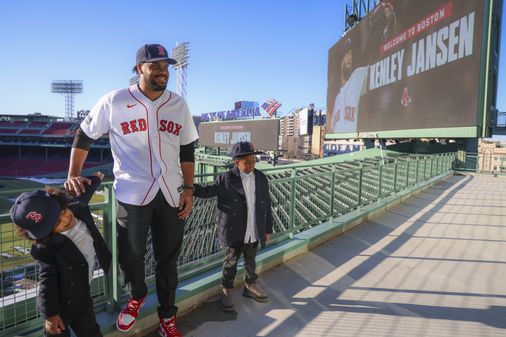“I saw my name and I was like, ‘Man, am I that slow?’ ” Jensen recounted.
In the middle of the 2022 season, Kenley Jansen had a revelation. Shortly after MLB announced plans to implement a pitch clock in 2023, Jansen saw his name prominently featured in a TV graphic of the pitchers who took the most time between pitches in baseball.
According to MLB.com’s pitch tempo measurements, with the bases empty, Jansen was the third slowest worker in the big leagues, taking 25.6 seconds from the time he released one pitch to the time he released the next, 7.5 seconds slower than the league average. He also held the title of the slowest worker in MLB with one or more runners on base, going 31.4 seconds from the time he released one pitch to the next — just over eight seconds slower than league average.
Get 108 Stitches A newsletter about everything baseball from the Globe’s Red Sox reporters, delivered weekdays during the season and weekly offseason. Enter Email Sign Up
That pace suggests Jansen is in for an adjustment next year, when MLB starts using a pitch clock. From the time they receive the ball from the catcher to when they release the ball (an act that takes about six fewer seconds than the pitch tempo measurements above), pitchers will have 15 seconds to throw a pitch with the bases empty and 20 with a runner on base.
Advertisement
Jansen said he’s not alarmed.
“Last year when I found out I was the slowest, I started to speed up myself a little bit. I was on the rubber and I was waiting for the hitter for so long … both sides have to adjust,” said Jansen. “I’m excited about it. We’re going to learn about it and it’s going to be fine.”
While the pitch clock will be new to MLB, it’s been employed in the minors for several years — including new limits of 15 seconds to release the ball with the bases empty and 19 with a runner on base in Triple A in 2022. While minor league pitchers had their gripes — whether frustration about having to rush after shaking off a catcher or the improved ability for runners to time a delivery — they adjusted to work within the rules.
Advertisement
“With minor leaguers, this has been part of the life and it definitely has tightened up in the last year,” said Red Sox pitching coordinator Shawn Haviland. “Your ERA depends on you not having to pitch 2-0 because you’re charged with a ball after not getting a pitch off in time. So you just make your adjustments.”
The adjustments won’t just be on the pitcher. Signals from the dugout will have to come more quickly. Catchers will have to call for pitches efficiently.
“The communication has got to be clean and crisp. Everyone is going to have to move faster,” said Sox pitching coach Dave Bush. “Whether guys like it or not, it’s going to be a new rule and it’s how the game is going to be played. The general feeling is most guys are willing to adapt to it. And that’s what Kenley alluded to. He’s one of the slower guys in the big leagues, but he doesn’t think it’s going to be a problem. He’ll figure it out and make an adjustment.”
Alex Speier can be reached at alex.speier@globe.com. Follow him on Twitter at @alexspeier.


